Related Research Articles
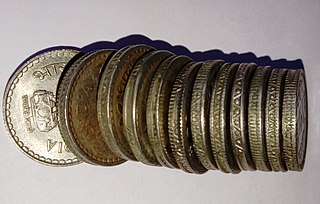
In numismatics, the term milled coinage is used to describe coins which are produced by some form of machine, rather than by manually hammering coin blanks between two dies or casting coins from dies.
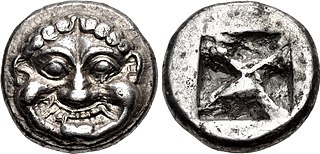
The history of ancient Greek coinage can be divided into four periods: the Archaic, the Classical, the Hellenistic and the Roman. The Archaic period extends from the introduction of coinage to the Greek world during the 7th century BC until the Persian Wars in about 480 BC. The Classical period then began, and lasted until the conquests of Alexander the Great in about 330 BC, which began the Hellenistic period, extending until the Roman absorption of the Greek world in the 1st century BC. The Greek cities continued to produce their own coins for several more centuries under Roman rule. The coins produced during this period are called Roman provincial coins or Greek Imperial Coins.

Michael Grant was an English classicist, numismatist, and author of numerous books on ancient history. His 1956 translation of Tacitus's Annals of Imperial Rome remains a standard of the work. Having studied and held a number of academic posts in the United Kingdom and the Middle East, he retired early to devote himself fully to writing. He once described himself as "one of the very few freelancers in the field of ancient history: a rare phenomenon". As a populariser, his hallmarks were his prolific output and his unwillingness to oversimplify or talk down to his readership. He published over 70 works.
From c. 1124 until 1709 the coinage of Scotland was unique, and minted locally. A wide variety of coins, such as the plack, bodle, bawbee, dollar and ryal were produced over that time. For trading purposes coins of Northumbria and various other places had been used before that time; and since 1709 those of the Kingdom of Great Britain, and then of the UK.

The Achaemenid Empire issued coins from 520 BC–450 BC to 330 BC. The Persian daric was the first gold coin which, along with a similar silver coin, the siglos represented the first bimetallic monetary standard. It seems that before the Persians issued their own coinage, a continuation of Lydian coinage under Persian rule is likely. Achaemenid coinage includes the official imperial issues, as well as coins issued by the Achaemenid provincial governors (satraps), such as those stationed in Asia Minor.
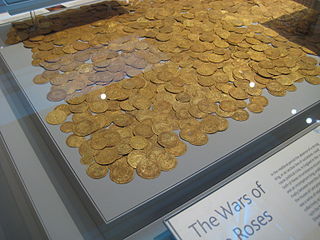
The British Museum Department of Coins and Medals is a department of the British Museum involving the collection, research and exhibition of numismatics, and comprising the largest library of numismatic artefacts in the United Kingdom, including almost one million coins, medals, tokens and other related objects. The collection spans the history of coinage from its origins in the 7th century BC to the present day, and is representative of both Eastern and Western numismatic traditions.
The Sylloge of the Coins of the British Isles (SCBI) is an ongoing project to publish all major museum collections and certain important private collections of British coins. Catalogues in the series contain full details and illustrations of each and every specimen. Every Anglo-Saxon and Norman coin included in the project can be viewed on the SCBI Database, based at the Department of Coins and Medals, Fitzwilliam Museum, Cambridge.
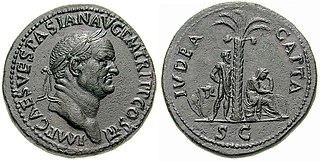
Judaea Capta coins were a series of commemorative coins originally issued by the Roman Emperor Vespasian to celebrate the capture of Judaea and the destruction of the Second Jewish Temple by his son Titus in 70 CE during the First Jewish Revolt. There are several variants of the coinage. The reverse of the coins may show a female seated right in an attitude of mourning at the base of a palm tree, with either a captive bearded male standing left, with his hands bound behind his back, or the standing figure of the victorious emperor, or the goddess Victoria, with a trophy of weapons, shields, and helmets to the left.
The Treasure Valuation Committee (TVC) is an advisory non-departmental public body of the Department for Culture, Media and Sport (DCMS) based in London, which offers expert advice to the government on items of declared treasure in England, Wales, and Northern Ireland that museums there may wish to acquire from the Crown.

Joe Cribb is a numismatist, specialising in Asian coinages, and in particular on coins of the Kushan Empire. His catalogues of Chinese silver currency ingots, and of ritual coins of Southeast Asia were the first detailed works on these subjects in English. With David Jongeward he published a catalogue of Kushan, Kushano-Sasanian and Kidarite Hun coins in the American Numismatic Society New York in 2015. In 2021 he was appointed Adjunct Professor of Numismatics at Hebei Normal University, China.
Martin Jessop Price was a British numismatist who was made a Merit Deputy Keeper of the British Museum in 1978, a corresponding member of the German Archaeological Institute and was a visiting fellow at the Institute for Advanced Study in Princeton, New Jersey, 1986-87. In 1992 he was awarded the medal of the Royal Numismatic Society. He was educated at King's School, Canterbury and Queens' College, Cambridge, where he graduated with a firsts in classics. In 1961, he won a Greek government scholarship which introduced him to the British School of Athens. In 1966, he was appointed Assistant Keeper in the Department of Coins and Medals at the British Museum, under Kenneth Jenkins, and was eventually appointed Deputy Keeper in 1978 which is a position he held until September 1994 when he became Director at the British School of Athens until his death.
Silk Road Numismatics is a special field within Silk Road studies and within numismatics. It is particularly important because it covers a part of the world where history is not always clear – either because the historical record is incomplete or is contested. For example, numismatics has played a central role in determining the chronology of the Kushan kings.
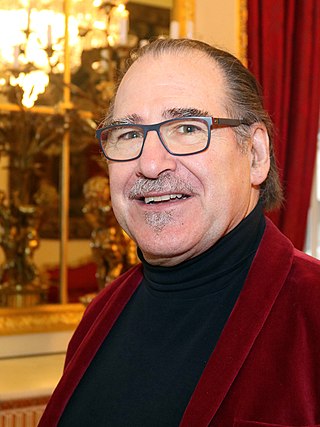
Jack Ogden, FSA, FGA, is a British jewellery historian with a particular interest in the development of Materials and technology. He is considered one of the foremost experts in his field. He is the current President of The Society of Jewellery Historians, having held the position since February 2018, and was appointed visiting professor of Ancient Jewellery, Material and Technology, at the Birmingham School of Jewellery Birmingham City University in 2019
The Lhotka Memorial Prize is a prize awarded to the author of a publication about numismatics which is considered most helpful to the elementary student of numismatics published in the previous two calendar years.

Bithynian coinage refers to coinage struck by the Kingdom of Bithynia that was situated on the coast of the Black Sea.
David Michael Metcalf was a British academic and numismatist. He was the director of the Heberden Coin Room of the Ashmolean Museum, a fellow of Wolfson College and Professor of Numismatics at the University of Oxford. He held the degrees of MA, DPhil and DLitt from Oxford.

Andrew Michael Burnett, is a British numismatist and museum curator, who specialises in Roman coins. He was Deputy Director of the British Museum from 2003 to 2013, and Keeper of its Department of Coins and Medals from 1992 to 2003. He was president of the Royal Numismatic Society from 2013 to 2018.
Andrew R. Woods is a British numismatist, archaeologist and curator specialising in early medieval and Viking coinage. He is the senior curator of the Yorkshire Museum and was formerly the curator of numismatics at the York Museums Trust.

Ute WartenbergFSA is a German numismatist and the first woman president and executive director of the American Numismatic Society (ANS). Wartenberg serves as an adjunct professor of classics at Columbia University and as the curator of the Amastris Collection, a private collection of Greek coins.
References
- ↑ Cover notes, Carradice, Ian, et al. (1999) The coin atlas: A comprehensive view of the coins of the world throughout history. London: Little, Brown. ISBN 1856054683
- ↑ Careers and Collections: A Symposium to mark Professor Ian Carradice’s Retirement. Claire Robinson, Museum Collections Blog, University of St Andrews. Retrieved 5 November 2015.
- ↑ Reappointment of Treasure Valuation Committee Members. Department for Culture, Media and Sport, February 2012. Retrieved 5 November 2015.